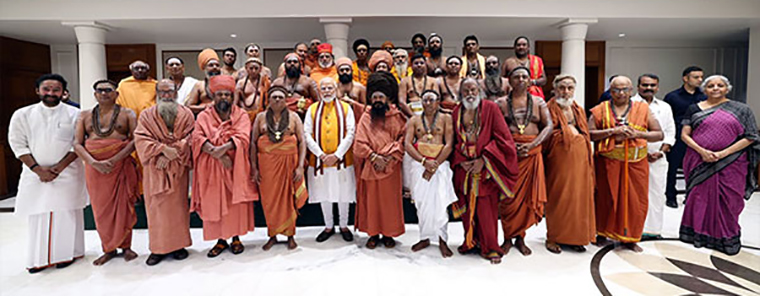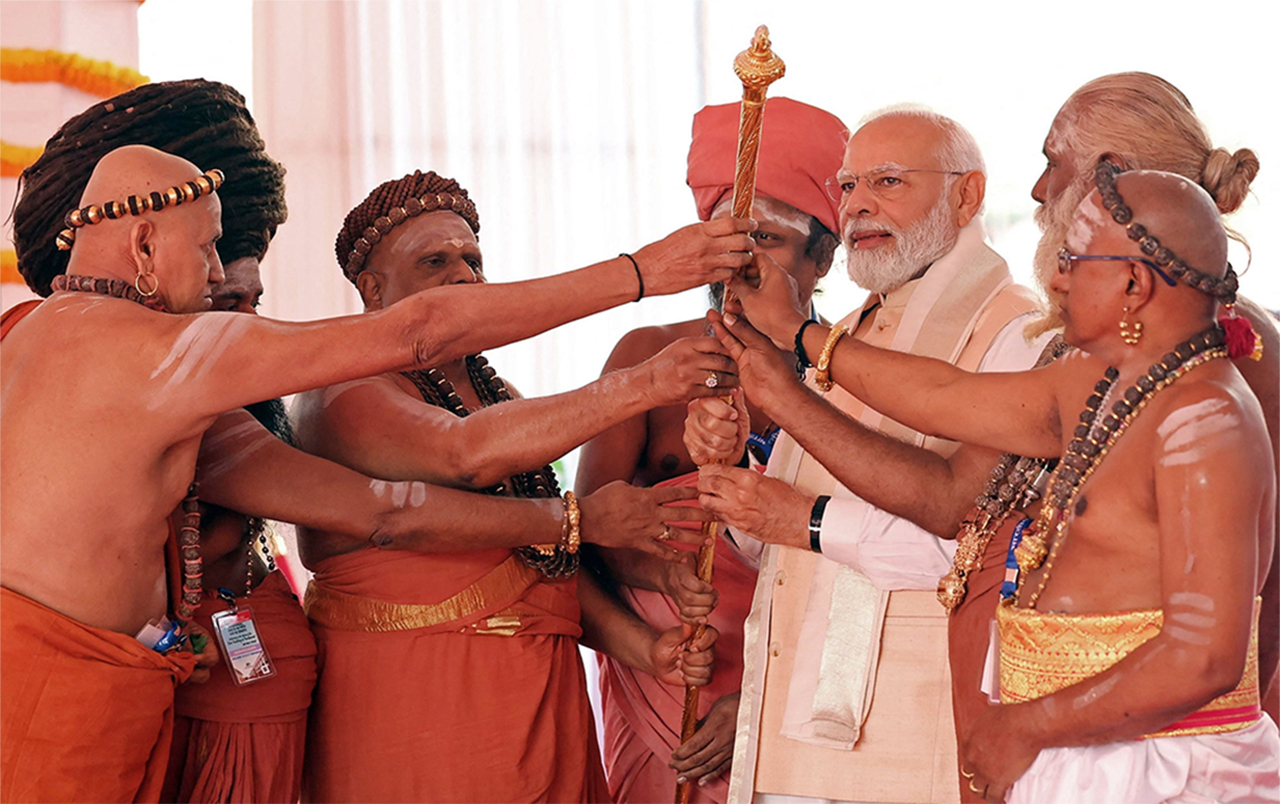No wonder Narendra Modi was silent when his betis (the wrestlers in this case) were protesting on the road and after being denied justice by his regime even decided to throw their medals in the Ganges. How can Modi sacrifice Brij Bhushan, a powerful Rajput Purush, for his “insignificant” wrestler betis? Is it possible in a Land Of The Men, For the Men and By the Men, asks Moumita Alam.
The picture of a female parliamentarian, who also happens to be the Finance Minister of this country, standing some distance aside from the male band of holy seers and saints, during the grand inauguration of the new Parliament building, circulating everywhere, from the Facebook timelines to the newspaper front pages, seems to photobomb the frame. Though the whole discussion is centred on the mainstream political narrative, that is how much India has progressed towards becoming a superpower under Modi, the shameless and obscene display of political Brahmanical Hindu rituals inside the Parliament sent shivers down the spine of those who want to see India as a secular democratic country. Not much is being written or said about the naked display of the extreme patriarchal manoeuvres of a government whose popular tagline of coming into power is Beti Bachao, Beti Padhao.

Finance Minister Nirmala Sitharaman at a photo session during inauguration of the new Parliament building
No journalist or news anchors have the courage, spine and integrity to ask the gentleman, does he know that outside of his grand palace, his “betis” are being dragged on the roads, humiliated and roughed up by his police force for seeking justice against one of his own men? Or why Nirmala Sitharaman, whose presence seems like a photo bomb, is the only woman in the picture? Or, where is Draupadi Murmu, the female Adivasi President of this country? Why was she not invited to the inauguration of the new Parliament building? Is it very tough to guess? Was it because of her caste and gender; her status as a widow?
Ok. Leave alone Draupadi Murmu. Where were the other female parliamentarians? Smriti Irani, the poster girl of BJP?
Maybe the answers are in the pictures of Vinesh Phogat, and Sakshi Malik along with the other wrestlers being dragged away by the police. They were holding the National flag. Even that couldn’t save them from being manhandled by the state apparatus; from the lathis of the police. The women supporters of the BJP who talk about the glorious past and nationalism should note this. Smriti Irani should note this, the female television anchors shouting their innards out and leaving no stones unturned to make us believe we are in Amrit kaal under the great Modi should note this.
Throughout ages, Indian politics whether Right or Left, has always put stress on Purush, with all the stressed air of the larynx on the word, “purush.” Like the feudal Zamindar or the family patriarch, the gentleman Modi doesn’t listen to anyone. He dislikes being questioned; he only gives sermons to his subjects (citizens of this democratic country) through his weekly man ki baat.
No wonder the Hindu majoritarian India with her inherent eternal obsession with “purush” is either silent or is hailing him as an avatar – a divine King. Every step of his coronation up to his prostration was telecasted live with utmost precision and reverence of patriarchal-obsessed submission. Emulating Kingly or Papal mannerisms, Modi holds up the holy Sengol and walks down the aisle of the Parliament house. And the whole India clapped in awe and admiration. With the historical myths of the great Kings rescuing the queens in distress, Modi is conscious of creating this image of him as a liberator. And who doesn’t know India is very prone to fall for the mythic and mystic halo of a conman? The con-King might be successful in his political mission but what does his rule mean for the common women?
In the first Lok Sabha in 1952, there were only 24 female parliamentarians. In the 17th Lok Sabha, it’s 78. From 24 to 78, it took India 67 years! And if we go through the parliamentary proceedings of post-independence India, no female parliamentarian irrespective of political parties and ideologies has escaped from the onslaught of misogynist, sexist vocabulary of Indian politics. It’s also undeniable that some women politicians themselves speak/spoke in the language of their male counterparts. They work/worked as the agent of patriarchy. Indira Gandhi, the only woman prime minister of India was called “gungi gudiya” by Ram Manohar Lohiya. A minister from the TMC party (whose supremo is Mamata Banerjee who herself faced sexism and suffered various name-calling) attacked President Draupadi Murmu for the colour of her skin.
Narendra Modi came to power in 2014. In the 2019 general election, it was found by Time magazine that one in seven tweets the women politicians receive on their twitter handles was abusive or problematic. From the Parliament to social media, India is out and out a male-dominated country. No wonder, India ranks 135 out of 157 in the gender inequality index.
With Narendra Modi aspiring to shuffle his image from a PM to a King-like avatar, it’s the women who are going to be the worst victims. And the pictures of Nirmala Sitharaman standing away keeping a distance or the picture of Smriti Irani peeping behind Amit Shah says it all. History is the witness that in a totalitarian regime, women always suffer the most. And in India, the suffering of women never ends. So politicians like Brij Bhushan enjoy absolute impunity while the champion daughters of India seeking justice are dragged on the streets of the nation’s capital city by the police. Women empowerment remains an empty slogan.
In the Panchayat level of governance, we can see the presence of more women panchayat members, but behind them always stand their husbands, or father or brother. The shadow of their husbands becomes larger than the women members. So in my village, if anyone sees Gour Sarkar, a very famous politician at the booth level, he is often asked, পঞ্চায়েত কেমন আছেন (How are you Panchayat?) Though in reality, he has never been elected as a Panchayat member! His wife was, during the Left Front rule in West Bengal. Yet, very few people know his wife’s name. So in the Panchayat election, every political party still prints demi ballot-paper and takes demi-votes from their voters. They fear that the voters will end up searching for the names of the candidate’s respective husbands during voting because it is they who take the major role during campaigning. The villagers hardly know and see the women candidates. The parties didn’t have a choice but to field female candidates due to reservation rules.
With the shameful revision of history syllabus and RSS calling the shots from behind, it’s horrifying to imagine how far India will go down the abyss of male chauvinism in the political domain. RSS doesn’t have women in Shakhas. Though RSS chief Mohan Bhagvat has been heard emphasising the participation of women in every frontal organisation, a right-wing organisation and political party can only use women to attract female voters but the word, “empowerment” needs much more. And the visual optics of the inauguration of the new parliament building speaks of the writing on the wall, it tells that women still need to go miles to be in the same frame as an equal member. The message is clear and the message has an eerie resemblance to the Nazis when Goebbels said, “The mission of women is to be beautiful and to bring children into the world.” Doesn’t it resemble Sakshi Maharaj’s advice to Hindu women to give birth to four children each?
No wonder Narendra Modi was silent when his betis (the wrestlers in this case) were protesting on the road and after being denied justice by his regime even decided to throw their medals in the Ganges. How can Modi sacrifice Brij Bhushan, a powerful Rajput Purush, for his “insignificant” wrestler betis? Is it possible in a Land Of The Men, For the Men and By the Men?
The author, Moumita Alam is a poet from West Bengal. Her poetry collection, The Musings of the Dark was published in 2020.

